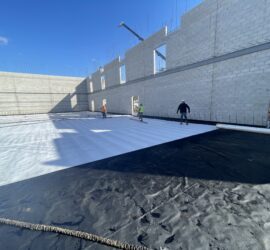Waterproofing Barrier System Definition
A waterproofing barrier system guarantees full protection to walls, foundations, and methane mitigation systems that are below grade and are susceptible to moisture penetration. Typically, the best way to protect a retaining wall against moisture is the application of a waterproofing barrier on the backside of it, after pouring concrete, but before backfilling soil. And the same applies to building footings and stem walls. However, with horizontal sub-slab applications, a waterproofing barrier system is installed prior to pouring the concrete slab.
Applications of a Waterproofing Barrier System & Membrane
A waterproofing barrier system is not equivalent to a de-watering system. Although in some cases, a waterproofing barrier can be part of an elaborate de-watering system. Moreover, a methane vapor barrier, which is necessary as part of the methane mitigation process, can also sometimes be a waterproofing barrier, depending on the application, make, and model of the membrane.




